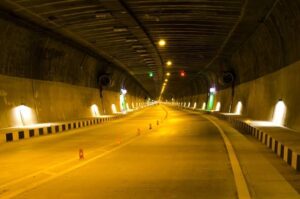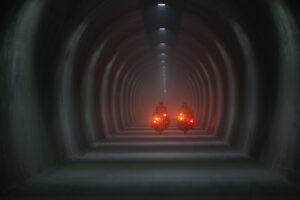Introduction
The Chenani – Nashri Tunnel (also known as Dr. Syama Prasad Mookerjee Tunnel) is India’s longest road tunnel completed in the Udhampur district of Jammu and Kashmir. The 9.2 km long road tunnel is a major road tunnel project in Northern India and the biggest of the country which includes (9 km Main Tunnel + 9 km Escape Tunnel + 1 km Cross Passage = total tunneling done is 19 km. The highest progress achieved in a Month from 4-Faces was 850 m which is a record in the Himalayan Tunnel by NATM.
IL&FS Transportation Network Limited has produced a Masterpiece, state of art tunnel, and this tunnel is a stunning example of an engineering marvel. The Shivalik mountain range of the great Himalayas now hosts India’s longest 2-way traffic road tunnel. This 9.2 Km tunnel is different from many other tunnels in India as well as other parts of the world as it is a two-lane tunnel with a parallel escape tunnel connected with 29 Nos. cross passages.
It will reduce 30 Km distance from Jammu to Srinagar and reduce traffic jams on NH – 1A that occur due to snowfall and avalanche in winter at Patnitop. In addition to the main road tunnel, there is a smaller parallel escape tunnel for emergency services for persons and extraction of smoke from a fully Transversal ventilation system in case of fire and accident.
The Uniqueness of the Project / Innovation done in Project
To achieve good progress under safe working conditions some innovation has been done Chennai – Nashri Tunnel Project.
- Use of poly fiber/steel shotcrete replacing traditional Wire mesh system.
- Using Swellex rock bolt immediately with a layer of sacrificial shotcrete.
- Deformation monitoring by reflex targets, pressure/load cell, and in extreme condition MPBX results to optimize the support.
- Probing (drilling up to 12 m advance at face) of the tunnel where ever suspicion of shear/fault zone and water ingress etc.
- Use of automatically navigated boomer (first time in India) for drilling which has resulted in a reduction drilling time and accuracy.
- Mucking time is reduced by using a 35-ton capacity articulated trailer called GHH- Germany made.
- A specialized team of Experts called in the tunneling field time to time for advice and suggestion.
- Unique electro-mechanical design and implementation procedures.
- Fully Integrated Tunnel Control System for the integration of Power supply, Traffic, Communication, Fire fighting & Ventilation.
- First in South East Asia and amongst very few tunnels across the world with transverse ventilation. Working in young immature Himalayan rocks and geological uncertainty in Himalayan terrain is a huge challenge. Overcame the same using the probabilistic approach and NATM rather than TBM.

Challenges Faces during Project Implementation
- The behavior of fly ash formations is not easily determined. Needed, careful and experienced blasting.
- Mixed Lithology & Challenges. Needed to optimize blast, else overbreak and muck would increase.
- Adopted multiple methods to overcome the geological challenges of the Himalayan region.
- Geological problems like sudden ingress of water in the North portal towards Nashri.
- Interception of shear/fault zones in the South portal because of negotiating low vertical and lateral cover zones.
- In the middle of the tunnel where the rock cover was 1050 m, high-stress conditions appeared inside the tunnel resulting in rock bursting and squeezing.
- Road connectivity due to landslides, snowfall, and traffic jams were also major huddles many days in the raining and winter season during the execution of Project.
- Social and Political reasons also disrupted the project work in tendon many days.
- Labour unrest was the most affecting factor that has a disruption in the execution of the project for more than 150 days.

Geology
Rock mass: Sedimentary deposits of mudstone and sandstone of the Murree Formation with a typical alternation of sandstone and siltstone or claystone beds.
Lithologies
- Sandstone – Grey to purple, fine to coarse-grained, high strength, massive to joint. Closely to highly jointed with infill of medium strength. Thickness varies from 2 to 12 m.
- Siltstone – Fine-grained with well – developed bedding laminations. Thickness varies from few centimeters to meters; often inter-bedded with the claystone.
- Claystone – Dark purple, fine-grained, soft to fairly hard, highly jointed with susceptibility to weathering, friable when dry. Typically thinly bedded.
UCS of Rocks :
Sandstone : 70 – 120 MPa
Siltstone : 25 – 40 MPa
Claystone : 8 – 15 MPa
Concrete Grades used in the Project
In the project, various grades of concrete starting from M15 to M40 were used. Different grades were used for different application as shown below :
- M15 for PCC
- M25 for Shotcrete
- M30 for Lining
- M35 for Retaining walls
- M45 for Bridges
Construction of the Chenani – Nashri Tunnel
Construction used the New Austrian Tunneling Method (NATM) Technique. Under NATM, the tunnel was sequentially excavated and supported. The project was of complex and complicated nature as it involved cutting of Himalayan rocks. Advanced tunneling and drilling equipment were used for the project.
Tunnel construction began in September 2011 and was completed in early 2017.
Trinitrotoluene (TNT) explosions were used during the starting phase of tunnel construction through the hills. The project involved the overall construction of a 10.9 Km long highway, including the 9.2 Km tunnel, a 50 m single-span bridge at the north portal of the tunnel, and a 40 m single-span approaching bridge at the south threshold.
The south section required surface works of 1.3 Km, while the north approaching portal required 0.6 Km of embankments and slope cuttings. Other infrastructure and supporting structures included technological and service buildings, toll plazas, other project facilities, and soil dump areas.

Impediments
Chenani – Nashri Tunnel is found to be challenging during excavation of the tunnel due to uncertain, difficult, extremely variable, and complex geological conditions emerging out of the young Himalayan mountain building process.
Moreover, extremely rugged, densely forested, and inaccessible topography limit the scope for investigation which finally becomes a cause of concern during execution due to geological problems like sudden ingress of water in the North portal towards Nashri and interception of shear/fault zones in the South portal because negotiating low vertical and lateral cover zones and at Middle high-stress conditions inside tunnel resulting in rock bursting and squeezing, high-temperature condition inside tunnels.
Road connectivity due to landslides, snowfall, and the traffic jams were also a major huddle many days in the raining and winter season during the execution of the project.
Social and political reasons also disrupted the Project work in tendon many days.
Labour unrest was the most affecting factor that has a disruption in the execution of the project for more than 150 days.
Special Safety Features
Chenani Nashri Tunnel which is an underground safety standard to be adopted to ensure safe and efficient passage to commuters.
International safety standards have been adopted for this tunnel:
- Redundancy in the system
- Entrance vehicle detection
- Automated smoke & Fire Alarm
- Automatic Incident Detection
- Integrated Traffic Control
- Automated control of traffic per incidence
- Automatic VMS
- Public Address System (Global & Local)
- Re – Broadcasting & Breaking of Fm
- Dedicated VHF network
- Fire fighting with hydrants and active suppression using the latest vehicle-mounted system
- Integrated system control of Ventilation. Traffic, Tolling, etc.
- Special assistance to the differently-abled person

Some Interesting Facts about the Chenani – Nashri Tunnel is as below:
- The construction cost of Chenani – Nashri Tunnel is Rs 3720 crore, the tunnel will reduce the distance between Jammu and Srinagar from 41 Km to 9.2 Km
- 1500 Engineers, Geologist, Skilled workers and Labours worked on the project
- 92.7 FM is mandatory for vehicles for quick response where emergency messages will be relayed
- 6000 LED multiple color lights will be used to break the monotony
- GSM phones will work inside the tunnel. 118 SOS boxes have been set up, one every 150 meters on both sides
- Smoke and heat dampeners will react quickly in fire incidents or occurrence
- 118 CCTVs, one every 75 meters
- At 50 Km/hr speed, the tunnel is 12 minutes to 15 minutes drive
- Each tube has a diameter of 13 meters, while sideway has a diameter of 6 meters
- Rs. 27 Lakh fuel savings a day
- Consist of two tubes and 29 cross – passages, with a special lane for exigencies
- Air quality monitors every 12 meters will check on carbon dioxide and carbon monoxide, guiding exhaust fans and air purification
- Automated Integrated Traffic Control System will monitor traffic round-the-clock and overhead vehicle will be made to stop for cooling off
- Vehicle distance to be maintained at three meters
- Dedicated of the Tunnel to the Nation: Chenani – Nashri Tunnel was dedicated to Nation on 2nd April, 2017 by Honorable Prime Minister of India Sh. Narendra Modi.

